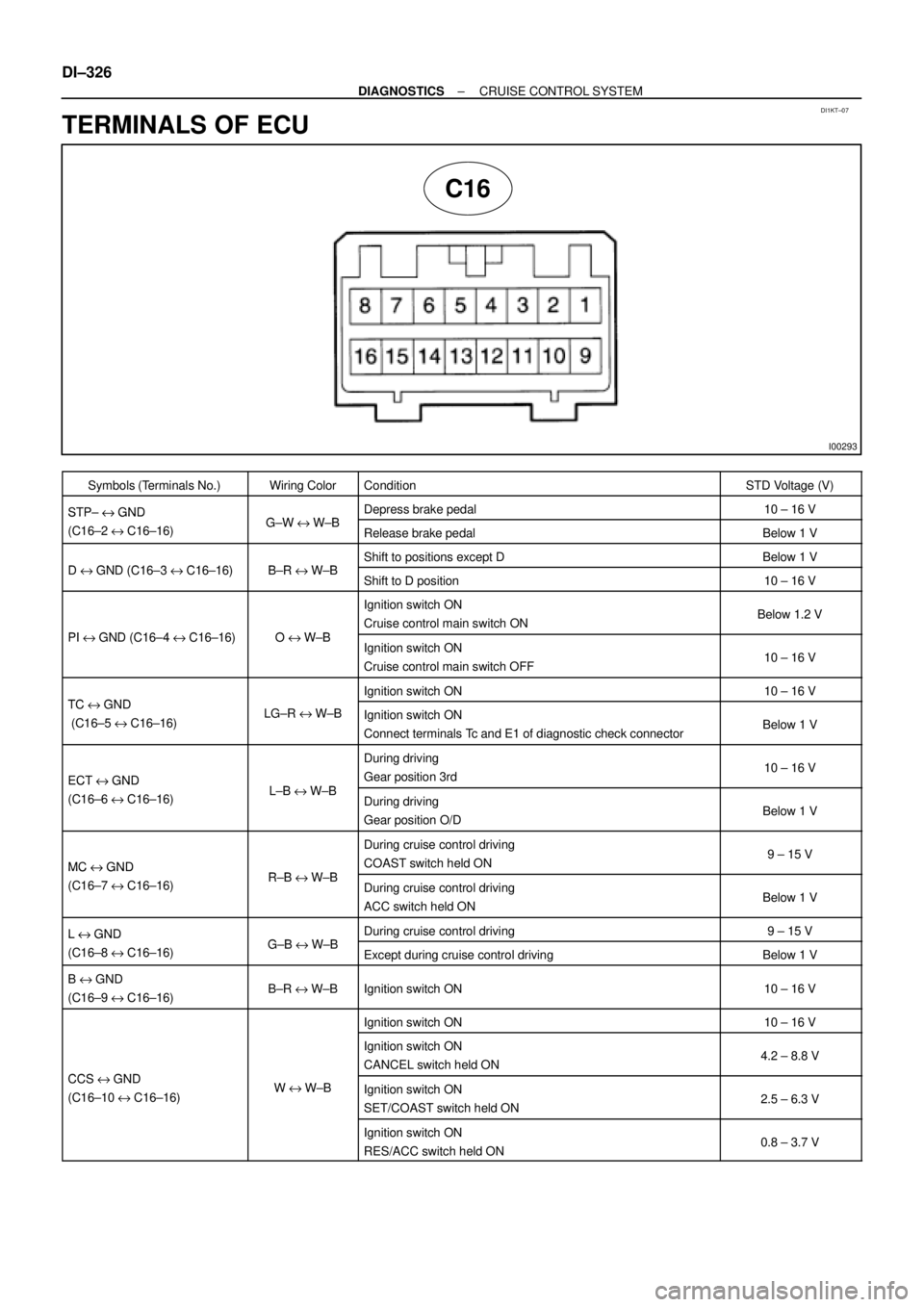Page 2475 of 4592

N17520
(1)
(2)
(1)
No.Operation MethodCRUISE MAIN Indicator Light
Blinking PatternDiagnosis
1 Turn SET/COAST switch ON
2Turn RES/ACC switch ON
3Turn CANCEL switch ON
Turn stop light switch ON
Depress brake pedal
Turn PNP switch OFF
(Shift to except D position)
4Drive at about 40 km/h
(25 mph)or higher
Drive at about 40 km/h
(25 mph) or below
LightON
OFF
LightON
OFF
LightON
OFFSwitch ON
Switch OFF
LightON
OFFSwitch OFF
Switch ONSET/COAST switch circuit
is normal
RES/ACC switch circuit
is normal
CANCEL switch circuit
is normal
Stop light switch circuit
is normal
PNP switch circuit is
normal
Vehicle Speed Sensor is
normal
LightON
OFF LightON
OFF
1sec.
0.25 sec.0.25 sec.
± DIAGNOSTICSCRUISE CONTROL SYSTEM
DI±323
5. INPUT SIGNAL CHECK
HINT:
(1): For check No.1 ± No.3
�Turn ignition switch ON.
(2): For check No.4
�Jack up the vehicle.
�Start the engine.
�Shift to D position.
(a) Pull the control switch to SET/COAST or RES/ACC posi-
tion and hold it down or up (1).
(b) Push the main switch ON (2).
(c) Check that the CRUISE MAIN indicator light blinks twice
or 3 times repeatedly after 3 seconds.
(d) Turn the SET/COAST or RES/ACC switch OFF.
(e) Operate each switch as listed in the table below.
(f) Read the blinking pattern of the CRUISE MAIN indicator
light.
(g) After performing the check, turn the main switch OFF.
HINT:
When 2 or more signals are input to the ECU, the lowest num-
bered code will be displayed first.
Page 2478 of 4592

DI1KT±07
I00293
C16
DI±326
± DIAGNOSTICSCRUISE CONTROL SYSTEM
TERMINALS OF ECU
Symbols (Terminals No.)Wiring ColorConditionSTD Voltage (V)
STP± e GND GWWBDepress brake pedal10 ± 16 VSTP e GND
(C16±2 e C16±16)G±W e W±BRelease brake pedalBelow 1 V
DGND (C16 3C16 16)BRWBShift to positions except DBelow 1 VD e GND (C16±3 e C16±16)B±R e W±BShift to D position10 ± 16 V
PIGND (C16 4C16 16)OWB
Ignition switch ON
Cruise control main switch ONBelow 1.2 V
PI e GND (C16±4 e C16±16)O e W±BIgnition switch ON
Cruise control main switch OFF10 ± 16 V
TCGNDIgnition switch ON10 ± 16 VTC e GND
(C16±5 e C16±16)LG±R e W±BIgnition switch ON
Connect terminals Tc and E1 of diagnostic check connectorBelow 1 V
ECT e GND LBWB
During driving
Gear position 3rd10 ± 16 VECT e GND
(C16±6 e C16±16)L±B e W±BDuring driving
Gear position O/DBelow 1 V
MC e GND RBWB
During cruise control driving
COAST switch held ON9 ± 15 VMC e GND
(C16±7 e C16±16)R±B e W±BDuring cruise control driving
ACC switch held ONBelow 1 V
L e GND GBWBDuring cruise control driving9 ± 15 VL e GND
(C16±8 e C16±16)G±B e W±BExcept during cruise control drivingBelow 1 V
B e GND
(C16±9 e C16±16)B±R e W±BIgnition switch ON10 ± 16 V
Ignition switch ON10 ± 16 V
CCSGND
Ignition switch ON
CANCEL switch held ON4.2 ± 8.8 V
CCS e GND
(C16±10 e C16±16)W e W±BIgnition switch ON
SET/COAST switch held ON2.5 ± 6.3 V
Ignition switch ON
RES/ACC switch held ON0.8 ± 3.7 V
Page 2479 of 4592
± DIAGNOSTICSCRUISE CONTROL SYSTEM
DI±327
Symbols (Terminals No.)Wiring ColorConditionSTD Voltage (V)
CMS e GND WLWB
Ignition switch ON
Main switch OFF10 ± 16 VCMS e GND
(C16±11 e C16±16)W±L e W±BIgnition switch ON
Main switch ONBelow 0.5 V
SPD e GND
(C16 12C16 16)V±W e W±B
Engine start
Car stoppage.Below 1.5 V or
4.7 ± 16 V
(C16±12 e C16±16)VW e WB
During driving (Pulse generated).3 ± 7 V
IDL e GND LRWB
Ignition switch ON
Throttle valve fully opened.10 ± 16 VIDL e GND
(C16±13 e C16±16)L±R e W±BIgnition switch ON
Throttle valve fully closed.Below 1.5 V
OD e GNDYBWB
During cruise control driving
OD switch ON.10 ± 16 VOD e GND
(C16±14 e C16±16)Y±B e W±BDuring cruise control driving
OD switch OFF (3rd driving)Below 1 V
MO e GND RGWB
During cruise control driving
ACC switch hold ON9 ± 15 VMO e GND
(C16±15 e C16±16)R±G e W±BDuring cruise control driving
COAST switch hold ONBelow 1 V
GND e Body Ground
(C16±16 e Body Ground)W±B e Body
GroundConstantBelow 1 V
Page 2482 of 4592
I00004
I00151
ON
2
1
DI±330
± DIAGNOSTICSCRUISE CONTROL SYSTEM
INSPECTION PROCEDURE
1 Check resistance between terminals MO and MC of actuator motor.
PREPARATION:
(a) Turn ignition switch ON.
(b) Disconnect the actuator connector.
CHECK:
Measure resistance between terminals 1 and 2.
HINT:
If control plate is in fully opened or fully closed positions, resis-
tance can not be measured.
OK:
Resistance: more than 4.2 W
NG Replace cruise control actuator.
OK
2 Check for open and short in harness and connectors between cruise control
ECU and actuator motor (See page IN±29).
NG Repair or replace harness or connector.
OK
Check and replace cruise control ECU
(See page IN±29).
Page 2484 of 4592
I00157
Instrument panel junction block No.1:
STOP Fuse
I00133
21
43
DI±332
± DIAGNOSTICSCRUISE CONTROL SYSTEM
INSPECTION PROCEDURE
1 Check STOP fuse.
PREPARATION:
(a) Turn ignition switch OFF.
(b) Remove the STOP fuse from instrument panel junction
block No.1.
CHECK:
Check fuse continuity.
OK:
There is continuity.
NG Replace STOP fuse.
OK
2 Check stop light switch.
PREPARATION:
Disconnect the stop light switch connector.
CHECK:
Check continuity between terminals.
Switch positionContinuity
Switch pin free
(Brake pedal depressed)1 ± 2
Switch pin pushed in
(Brake pedal released)3 ± 4
NG Replace stop light switch.
OK
Page 2485 of 4592
I00311
4
3
± DIAGNOSTICSCRUISE CONTROL SYSTEM
DI±333
3 Check resistance between terminals L and GND of actuator magnetic clutch.
PREPARATION:
(a) Turn ignition switch OFF.
(b) Disconnect the actuator connector.
CHECK:
Measure resistance between terminals 3 and 4.
OK:
Resistance: 34.65 ± 42.35 W
NG Replace cruise control actuator.
OK
4 Check for open and short in harness and connectors between cruise control
ECU and actuator magnetic clutch, actuator magnetic clutch and body ground
(See page IN±29).
NG Repair or replace harness or connector.
OK
Check and replace cruise control ECU
(See page IN±29).
Page 2486 of 4592
I00055
4
3(+)
(±)
DI±334
± DIAGNOSTICSCRUISE CONTROL SYSTEM
DTC 14 Actuator Mechanical Malfunction
CIRCUIT DESCRIPTION
The circuit detects the rotation position of the actuator control plate and sends a signal to the ECU.
DTC No.DTC Detecting ConditionTrouble Area
14Cruise control actuator mechanical malfunction.
�Actuator lock: (motor, arm)
�Actuator motor
�Cruise control ECU
WIRING DIAGRAM
See page DI±329.
INSPECTION PROCEDURE
1 Check cruise control actuator arm locking operation
PREPARATION:
(a) Turn ignition switch OFF.
(b) Disconnect the actuator connector.
CHECK:
Connect the positive (+) lead from the battery to the terminal 3
of actuator and the negative (±) lead to terminal 4.
NOTICE:
Do not connect the high tension cables to the wrong bat-
tery terminal. The cruise control actuator will be damaged.
Move the control plate by hand.
OK:
Control plate doesn't move.
NG Replace cruise control actuator.
OK
DI08O±13
Page 2487 of 4592
I08437
Fully open side
Fully Closed sideControl plate
Control plate4
321
4
321
± DIAGNOSTICSCRUISE CONTROL SYSTEM
DI±335
2 Check cruise control actuator operation.
PREPARATION:
(a) Turn ignition switch OFF.
(b) Disconnect the actuator connector.
CHECK:
Connect the positive (+) lead from the battery to terminals 1 and
3 of actuator, connect the negative (±) lead to terminals 2 and
4 of actuator.
OK:
Control arm moves to fully open side
CHECK:
Connect the positive (+) lead from the battery to terminals 2 and
3 of actuator, connect the negative (±) lead to terminals 1 and
4 of actuator.
OK:
Control arm moves to fully colsed side
NG Replace cruise control actuator.
OK
3 Check harness and connector between cruise control ECU and cruise control ac-
tuator (See page IN±29).
NG Repair or replace harness or connector.
OK
Check and replace cruise control ECU
(See page IN±29).